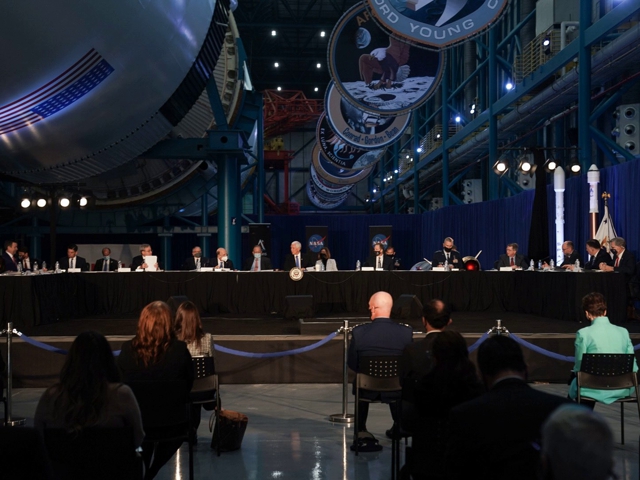The White House launches the US National Space Policy, recognizing the Department of Defense (DoD) and the Intelligence Community (IC) as co-equal partners for national security in space.
“For the first time, there will be a unified structure that fully integrates Intelligence and Defense plans, authorities, and capabilities to ensure seamless execution of space defense actions” — John Ratcliffe
Launched on December 9, 2020, the US National Space Policy is a framework for maintaining America’s lead in space development and exploration for the “advancement of all humanity,” and for dealing with foreign adversaries like China and Russia who have already weaponized space.
Under the new policy, the Pentagon and the Intelligence Community are required to coordinate with one another for various operations.
The National Space Policy lists 15 ways in which the DoD and IC will work together, some of which include:
- Developing and applying advanced technologies, capabilities, and concepts that anticipate and rapidly respond to changes in the threat environment and improve the timeliness and quality of intelligence and data to support operations
- Identifying and characterizing current and future threats to United States space missions for the purposes of enabling effective deterrence and defense
- Integrating cybersecurity into space operations and capabilities to retain positive control of space systems and verify the integrity of critical functions, missions, and services they provide
- Collaborating with the Secretaries of Commerce and Energy, the Administrator of NASA, and the heads of other relevant agencies to periodically review the health and competitiveness of the United States space industrial base to determine whether the domestic space industry can meet the technical requirements, production, and service of national security space programs
“The new National Space Policy recognizes that the Intelligence Community and the Department of Defense are co-equal partners in the national security space enterprise,” said Director of National Intelligence John Ratcliffe, during the National Space Council meeting on Wednesday.
“For the first time, there will be a unified structure that fully integrates Intelligence and Defense plans, authorities, and capabilities to ensure seamless execution of space defense actions,” he added.
Ratcliffe went on to report that his team is looking to make the Space Force the 18th member of the Intelligence Community.
“I am pleased to report that my team at the ODNI [Office of the Director of National Intelligence] is working with the Space Force leadership to evaluate the potential for the Space Force to become the 18th member of the US Intelligence Community,” said Ratcliffe.
“We anticipate a decision on this history-making opportunity in the next few months, which would profoundly strengthen the partnership between the Department of Defense and the Intelligence Community,” he added.
“ODNI is working with the Space Force leadership to evaluate the potential for the Space Force to become the 18th member of the US Intelligence Community” — John Ratcliffe
The Director of National Intelligence also announced plans for the creation of a National Space Intelligence Center.
“We are working directly with the Space Force leadership team to create a new ‘National Space Intelligence Center,’ which will deliver the intelligence support necessary to achieve our national security objectives,” he said.
“The establishment of this new center will provide the nation unparalleled scientific and technical intelligence on space-related threats, and it will serve as the service intelligence center for the Space Force.”
“We are working directly with the Space Force leadership team to create a new National Space Intelligence Center” — John Ratcliffe
According to the Springfield News-Sun, Wright-Patterson Air Force Base will house the National Space Intelligence Center.
And Air Force Magazine reported in November, “Two pieces of the National Air and Space Intelligence Center at Wright-Patterson Air Force Base, Ohio, will form the basis of a new National Space Intelligence Center […] Those units are the Space Analysis Squadron and Counter-Space Analysis Squadron.”
“China poses the greatest national security threat to the United States” — John Ratcliffe
Earth faces many space-based threats. Over 20,000 pieces of space debris orbit the planet, and a collision could be hazardous to the astronauts onboard the International Space Station, and also affect GPS and communications on Earth.
Space weather is another challenge, including geomagnetic storms that could disrupt the world’s power grids.
But for America’s defense and intelligence communities, China remains the biggest national security and counterintelligence threat, followed closely by Russia.
“America’s vital interests are increasingly at risk as China and Russia develop and field destructive weapons to threaten US and allied space capabilities,” said Ratcliffe.
“The intelligence is clear: China poses the greatest national security threat to the United States.”
In September, former Secretary of Defense and member of the Council on Foreign Relations Mark Esper warned that Beijing and Moscow had weaponized space with “killer satellites” and directed energy weapons. Esper was replaced by Acting Secretary of Defense Christopher Miller, when the latter was appointed on November 9.
“Should any adversary threaten to endanger the benefits we all derive from space, the United States will employ all elements of national power to deter and, if necessary, prevail over hostile activities in, from, and through space” — National Space Policy
On Wednesday, Ratcliffe echoed Esper’s warning about killer satellites from foreign adversaries, highlighting that:
- China is pursuing weapons capable of destroying our satellites up to geosynchronous Earth orbit, where many critical space systems reside
- China has also deployed a ground-based missile intended to target and destroy satellites in low Earth orbit
- Russia has a similar system in development that is likely to be operational in the next several years
- Russia has also fielded a ground-based laser weapon, which could blind or damage our space-based optical sensors
In his opening remarks on Wednesday, Vice President Mike Pence also warned that China and Russia were weaponizing space, and that was one of the reasons for establishing the Space Force.
“China recently landed an unmanned craft on the Moon, and, for the first time, robotically raised the red flag of Communist China on that Magnificent Desolation” — Vice President Mike Pence
“China and Russia are continuing to develop space weaponry,” said Pence.
“Russia demonstrated a space-based anti-satellite weapon earlier this year. China is developing a new manned space station, and its robotic spacecraft will return samples from the Moon in just a matter of weeks.
“In fact, China is increasingly emerging as a serious competitor in space, just as they are in other areas of the global economy and to the strategic interest of the United States.
“As the world witnessed, China recently landed an unmanned craft on the Moon, and, for the first time, robotically raised the red flag of Communist China on that Magnificent Desolation.”
“The United States has been, and will remain, committed to fostering the ingenuity of the American people and working with likeminded partners around the world to improve our quality of life, to explore and learn, and to support peace on Earth and in the stars” — US National Space Policy
The US National Space Policy prioritizes several key goals in its commitment to space development and exploration, including:
- Promoting and incentivizing private industry
- Encouraging and upholding the rights of nations to use space responsibly and peacefully
- Leading, encouraging, and expanding international cooperation
- Creating a safe, stable, secure, and sustainable environment for space activities
- Increasing the assurance of national critical functions enabled by commercial, civil, scientific, and national security spacecraft
- Extending human economic activity into deep space (i.e. establishing a permanent human presence on the Moon, missions to Mars, etc.)
- Increasing the quality of life for all humanity
- Preserving and expanding United States leadership in the development of innovative space technologies, services, and operations
“The United States has been, and will remain, committed to fostering the ingenuity of the American people and working with likeminded partners around the world to improve our quality of life, to explore and learn, and to support peace on Earth and in the stars,” the National Space Policy declares.
“The United States will lead and strengthen enduring international partnerships to preserve and sustain space for future activity and so that all nations and all people can benefit from space and improve our way of living on Earth and in space.”
US defense intelligence warns of AI-human hybrid soldiers from China












